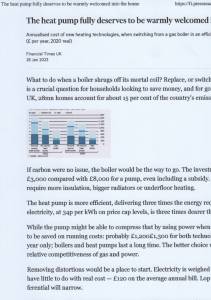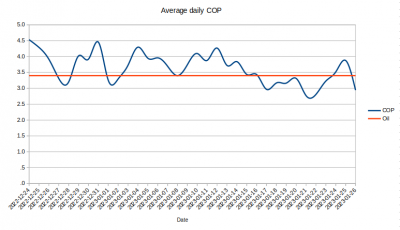Lobby the government for a realignment of electricity costs v gas
Posted by: @soniks@derek-m the grid are already getting ahead of the game in terms of the future electricification that is happening -
Also there have been papers written looking at future grid capacity and concluded it's far less problematic than previously thought - https://www.phamnews.co.uk/can-the-grid-cope-with-demand-the-argument-for-heat-pumps/#:~:text=%E2%80%9CHowever%2C%20unlike%20direct%20electric%2C,than%20air%20source%20heat%20pumps.%E2%80%9D
I think the point being made is there is more renewable generation now than ever before and that trend will continue given the government targets to fully decarbonise.
Did you watch the same video as I did, because the one I watched did not exactly fill me with confidence.
You need to be aware that there are the electricity generation companies producing the electrical energy, then what used to be called National Grid, but has been renamed the Electricity System Operator, who moves the electrical energy around in bulk at high voltage. The final link in the chain are the District Network Operators (DNO), one of which has now been renamed National Grid, who eventually supply the consumers.
For the whole system to work, each link in the chain has to function correctly, 24 hours per day, 365 days per year.
I think the point being made is there is more renewable generation now than ever before and that trend will continue given the government targets to fully decarbonise.
I welcome the fact that there is more renewable generation, but that is only of use if it is actually generating, in the past we had loads of coal fired power stations, which in the Summer months were often being overhauled so that they could operate at full capacity when required during the Winter months. The major problem with renewable generation is that it is not consistently available when required, and I don't think that many consumers would be too happy if they were told that they can only run their heat pump and charge their EV, if the wind is blowing or the Sun is shining.
Whilst your DNO can install the largest cables for which you can afford pay, they will be of little use if there is no electrical energy available to send down them, because the consumers in the local town have taken all the available supply to run their heat pumps and charge their EV's.
Article from this weekend's FT suggests that all-in annualised cost of ASHP will remain higher than that for gas for some years to come.
Mike
Grant Aerona HPID10 10kWh ASHP
Posted by: @mike-patrickannualised cost of ASHP will remain higher than that for gas for some years to come.
I wonder what CoP they are using and whether they are taking into account the future cost of the CO2 emitted.
I suspect that there will be house/location combinations in the UK where this is not the case. A case of macro level view vs micro level views.
I cannot produce my own gas or oil, but can potentially produce my own electricity and more easily store it at cheap times to reuse at more expensive times.
My own running cost calculations (having moved from oil) are as below (excluding capital investment). I will keep tracking this through the year as the oil prices change.
The government could tweak the Energy Price Guarantee at the next update which comes into force on the 1st April.
This will be £3000 on average for someone who typical consumption (12000kWh gas, 2900kWh electricity}. That is a 20% increase on the current £2500
They could shift more of the government subsidy to electricity rather than gas (they have already removed the green levy from electricity temporarily and covered it via general taxation} and keep the average £3000.
The next date to watch out for is 27 February 2023 when Ofgem release the next price cap. Be interesting to see how close the ofgem price cap is to the Energy Price Guarantee and how electricity unit prices compare with gas unit prices. There is a chance the ofgem price cap could fall below the energy price guarantee on 1st April rather than what looked like 1st July.
Summary article about how the high price of gas has driven high profits for many non fossil fuel electricity generators not on the recent better structured CfD contracts.
https://www.bbc.com/news/business-64471262
That is precisely what I have been saying for over the past year. The system should revert back to the previous model, where each generator had to bid in a price, which was then the amount they got paid, if they were called upon to supply.
The Government don't particularly care, since they can claw back some of the excess profit using windfall taxes, which are then used to help fund the various schemes, to show how the Government is 'taking care' of the consumers. Could be good for votes don't you think?
@derek-m There is a reason almost all electricity markets are on pay-as-clear rather than pay-as-bid. In pay-as-clear, the bidder is motivated to submit bids very close to their costs. In pay-as-bid, the bidder will attempt to guess the clearance price and bid accordingly. Also, large operators are likely to have better intel on where the clearance price may lie and have unfair advantage. Consequently, the pay-as-bid auctions often lead to inefficient operators winning the auctions and that has collateral damage. One may argue the efficient operator just needs to bid their lowest price but the margin from bidding at predicted clearance far outweighs that from taking the narrowest margin and is worth an occasional miss. There is a large body of research on this issue already.
In the ongoing REMA (Review of Electricity Market Arrangements) process, the possibility of pay-as-bid has been raised again. One option considered by REMA to make pay-by-bid work is to knobble bidders by setting bid ranges based on expected costs for that technology. If you are going there, perhaps you should forget about a market altogether. Water doesn't run on a market.
I have read the REMA consultation document and the thinking in it is interesting and poorly summarised in the press who appear to have missed the point altogether. I could put up a summary of those parts as a topic but I'm not altogether sure it would be appropriate or of general interest. They could have interesting impacts on how electricity gets paid for.
For anyone interested. Am not intending to summarise.
https://www.gov.uk/government/consultations/review-of-electricity-market-arrangements
- 26 Forums
- 2,342 Topics
- 53 K Posts
- 773 Online
- 6,000 Members
Join Us!
Worth Watching
Latest Posts
-
-
RE: External pipework insulation
Question the current insulation you see, does that look...
By jeegnesh , 41 minutes ago
-
RE: Controlling Daikin Altherma via P1P2 and Home Assistant
@majordennisbloodnok That’s correct. I can’t find anywh...
By weoleyric , 5 hours ago
-
RE: Octopus Cosy Heat Pump Owners & Discussion Thread
@andrewj yeah we recreated it. Engineer seemed to think...
By swwils , 6 hours ago
-

RE: Configuring third party dongle for Ecodan local control
That's a good spot and a valuable insight, @sheriff-fat...
By Majordennisbloodnok , 9 hours ago
-

RE: Are We Sleepwalking Into Another Race to the Bottom?
@majordennisbloodnok And did ‘Honey’ order it for you? ...
By Toodles , 9 hours ago
-

RE: Setback savings - fact or fiction?
@robs — thanks again for your detailed comments. Some r...
By cathodeRay , 23 hours ago
-

RE: A Smarter Smart Controller from Homely?
@papahuhu I hope you get a swift resolution. Regards, T...
By Toodles , 1 day ago
-

RE: Poll for Time of Use, tariffs, technology
That’s fine by me too Major, I feel it is a sad reflect...
By Toodles , 1 day ago
-

Bingo. Sometimes a judiciously placed size 10 bovver bo...
By Majordennisbloodnok , 1 day ago
-
RE: Mitsubishi Ecodan 11.2kW heat pump with low COP
@ciocoiu-alexandru I can't provide the same level of di...
By Sheriff Fatman , 1 day ago
-

The three technical issues I'm considering are: BMS...
By Transparent , 1 day ago
-
RE: LiFePO4 lithium battery fires and explosions
@transparent Your post may fit better in th...
By Batpred , 1 day ago
-

RE: British Gas vs Octopus Energy vs Heat Geek vs EDF vs Aira vs OVO vs EON.Next vs Boxt
@jamespawhite, if you could be bothered, you could also...
By Mars , 1 day ago
-
RE: Commencing on an ASHP Installation Process
I've got a bit of time to draft something today, so the...
By Sheriff Fatman , 2 days ago
-
RE: Help with heat pump sizing
@amin I dont think materially relative to t...
By JamesPa , 2 days ago
-

@majordennisbloodnok I have decided to take the plunge....
By TechnoGeek , 2 days ago
-
RE: Different dT on each radiator?
I cant sorry. Its based on some calculations I did fro...
By JamesPa , 3 days ago






